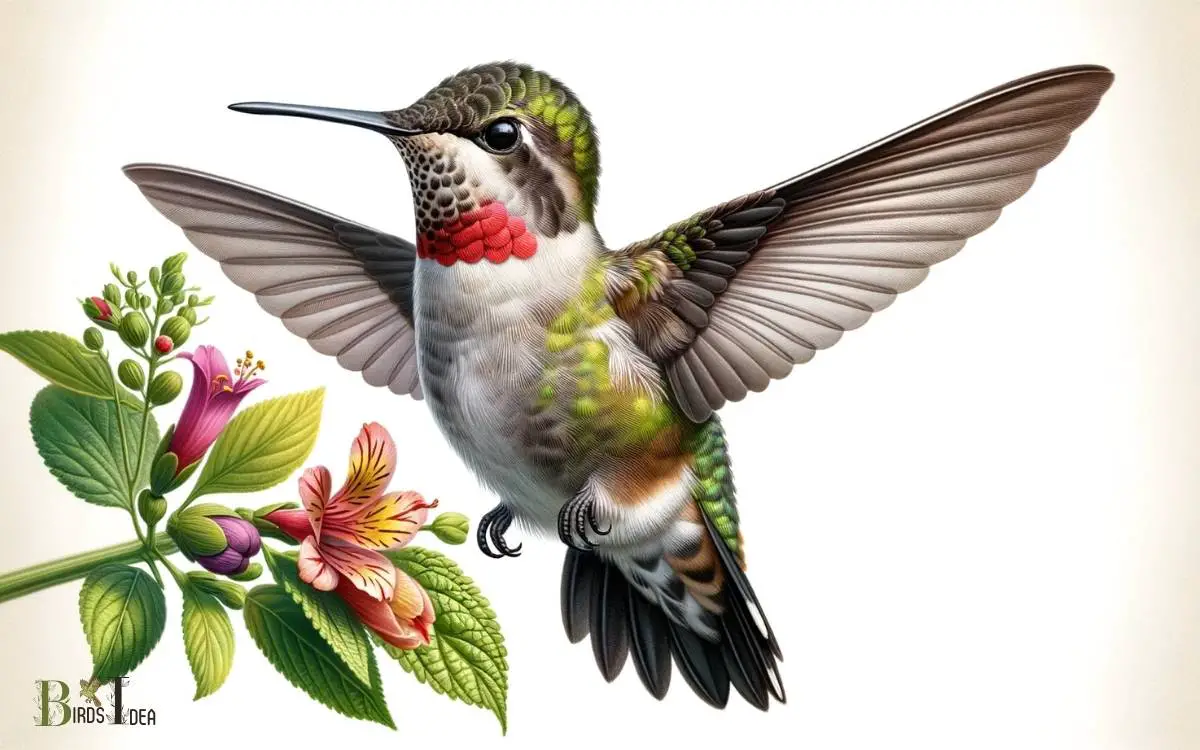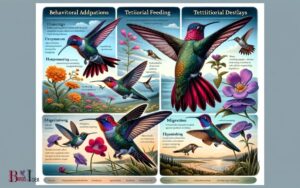Young Male Ruby Throated Hummingbird: Explore!
The Ruby-Throated Hummingbird (Archilochus colubris) is an enchanting bird species, particularly the young males with their iridescent green backs and vivid ruby-red throats.
These tiny birds, weighing around 3 grams and spanning 3 to 4 inches across the wings, are a common sight in North America.
They play a crucial role in pollination and exhibit intriguing behaviors such as specialized feeding, mating rituals, nest building, and long-distance migration.
The Ruby-Throated Hummingbird is the only breeding hummingbird in eastern North America.
They are:
Discover the dazzling world of the Ruby-Throated Hummingbird, a jewel among North American avifauna.

Key Takeaway
10 Features: Young Male Ruby-Throated Hummingbird
| Feature | Description |
|---|---|
| Scientific Name | Archilochus colubris |
| Family | Trochilidae |
| Adult Weight | Approximately 3 grams |
| Wingspan | 3-4 inches |
| Distinctive Markings | Iridescent green back, ruby-red throat (in males) |
| Habitat | North America, particularly in the East |
| Migration | Travels to Central America in winter; crosses Gulf of Mexico |
| Feeding Habits | Primarily nectar; also small insects and spiders |
| Role in Ecosystem | Pollination of flowers |
| Conservation Status | Least Concern; faces habitat loss and predation risks |
Physical Characteristics
A young male Ruby-throated Hummingbird possesses distinctive physical characteristics that distinguish it from other hummingbird species. The most striking feature is the vibrant ruby-red throat patch, or gorget, which gives the species its name.
This patch, when caught in the right light, appears almost iridescent and serves as a key identifier for this particular species. The plumage of the young male is predominantly green, with a metallic sheen that shimmers in the sunlight.
The tail is forked and the wings are long and pointed, allowing for exceptional agility and maneuverability during flight.
The slender, slightly down-curved bill is perfectly adapted for reaching deep into flowers to extract nectar, their primary food source.
These physical characteristics collectively contribute to the unique and captivating appearance of the young male Ruby-throated Hummingbird.
Feeding Habits
The young male Ruby-throated Hummingbird primarily sustains itself through the consumption of nectar from flowers.
This tiny bird has fascinating feeding habits, which include:
- Specialized bill: The hummingbird’s long, slender bill is perfectly adapted for reaching deep into flowers to access nectar. The bill’s shape allows for precision feeding and helps in pollination as the bird moves from flower to flower.
- High metabolism: With a heart rate that can reach up to 1,260 beats per minute and the ability to consume up to double its body weight in food each day, the Ruby-throated Hummingbird is constantly seeking out nectar sources to fuel its high energy lifestyle.
- Insect consumption: In addition to nectar, these hummingbirds also consume insects and spiders, providing essential proteins and nutrients, especially during the breeding season.
Mating Behavior
When young male Ruby-throated Hummingbirds reach sexual maturity, they engage in elaborate courtship displays to attract potential mates.
These displays involve aerial acrobatics, rapid dives, and intricate patterns of flight, accompanied by chirping and buzzing sounds to impress females.
The males often perform these displays in specific areas within their territory, where females are more likely to observe their prowess.
Once a female shows interest, the male continues to impress her with his agility and stamina. As part of the courtship ritual, the male also produces complex vocalizations and may perform visual displays to further entice the female.
This elaborate courtship behavior is crucial for successful mating and passing on their genetic lineage.
| Mating Behavior Displays | Description |
|---|---|
| Aerial Acrobatics | Complex flight patterns and rapid maneuvers |
| Vocalizations | Intricate chirping and buzzing sounds |
| Visual Displays | Elaborate movements and posturing |
Nesting and Reproduction
The nesting habits and mating behaviors of the young male Ruby Throated Hummingbird display fascinating adaptations and intricate rituals.
These tiny birds meticulously construct their nests using materials such as spider silk and plant down, showcasing remarkable engineering skills.
Additionally, the courtship displays and territorial behaviors during the mating season are notable aspects of their reproductive behavior.
Nesting Habits
During the nesting season, young male Ruby Throated Hummingbirds exhibit distinct behaviors related to nesting and reproduction.
- Nest Construction: These hummingbirds are meticulous in building their nests, using plant fibers, downy feathers, and spider silk, weaving them together to create a strong and flexible structure that expands as the chicks grow.
- Courtship Feeding: The males perform elaborate courtship displays, including rapid dives and U-shaped flights to impress potential mates. They also offer food to the females as part of the courtship ritual, showcasing their ability to provide for the offspring.
- Incubation and Feeding: Once the female lays her eggs, she takes on the sole responsibility of incubating them, while the male continues to forage for food. After hatching, both parents diligently feed the chicks with nectar and insects.
These nesting habits are essential for the survival and growth of the hummingbird population.
These nesting habits are essential for the survival and growth of the hummingbird population, setting the stage for the subsequent section about ‘mating behaviors’.
Mating Behaviors
Young male Ruby Throated Hummingbird’s mating behaviors, particularly related to nesting and reproduction, involve intricate courtship displays and the provision of food to impress potential mates and demonstrate their ability to contribute to the offspring’s care.
During courtship, the male performs a remarkable display, often described as a “dive display” where he ascends 50 to 100 feet before diving in a U-shape pattern, creating a high-pitched noise with his tail feathers.
This display showcases his agility and strength, crucial for defending territory and gathering resources. Once successfully courted, the female builds a walnut-sized nest using plant down, spider silk, and lichens, often in a concealed location.
She then lays two white, pea-sized eggs, which she incubates for approximately 12-14 days. Post-hatching, the female feeds the chicks regurgitated nectar and insects.
Such intricate behaviors ensure the survival of the species. These behaviors ultimately prepare them for the next phase in their life cycle, the migration patterns.
Migration Patterns
A young male Ruby Throated Hummingbird exhibits distinct migration patterns, showcasing its remarkable journey across vast distances. This tiny bird embarks on an incredible migration, spanning up to 500 miles across the Gulf of Mexico.
The migration of the Ruby Throated Hummingbird is a marvel of endurance and navigation, involving the following key aspects:
- Timing: These birds commence their migration in response to environmental cues, such as changes in day length and food availability.
- Route: Their migration route often follows a specific path, guiding them through diverse landscapes and climates.
- Energetic Demands: The migration requires an immense amount of energy, compelling the hummingbirds to feed voraciously before undertaking their long journey.
Understanding the intricacies of the Ruby Throated Hummingbird’s migration provides valuable insights into its survival strategies and ecological significance.
Predators and Threats
The young male Ruby-throated hummingbird faces various predators and threats as it navigates its environment. Nesting near predators like snakes and larger birds poses a constant risk, requiring the hummingbird to be vigilant in protecting its nest.
Additionally, human-caused threats such as habitat destruction, pesticide use, and collisions with man-made structures further endanger the survival of these magnificent creatures.
Nesting Near Predators
Nesting near predators poses significant risks for the survival of Ruby Throated Hummingbirds.
- Increased predation risk: Proximity to predators such as snakes, cats, and larger birds heightens the potential for nest destruction and predation of eggs and chicks.
- Reduced survival rates: The presence of predators near nesting sites can lead to heightened stress levels, impacting the hummingbirds’ reproductive success and overall survival.
- Altered behavior: The constant threat of predation may force hummingbirds to spend more time and energy on vigilance and defense, diverting resources away from essential activities like foraging and chick rearing.
These factors highlight the challenges and dangers associated with nesting near predators, underscoring the need for hummingbirds to adopt strategies to mitigate these risks.
This constant threat underscores the importance of understanding how hummingbirds manage to avoid larger birds in their environment.
Avoiding Larger Birds
In the presence of larger birds, young male Ruby Throated Hummingbirds rely on strategic maneuvering to evade potential threats. These tiny birds have developed remarkable aerial skills to avoid larger avian predators.
When a threat is perceived, the hummingbird swiftly changes direction, accelerates, or ascends vertically, taking advantage of their exceptional agility and speed. Their rapid and erratic flight patterns make it difficult for larger birds to pursue them effectively.
Additionally, they often seek refuge in dense vegetation or utilize their small size to hide in foliage, further reducing the risk of predation.
This behavior showcases the hummingbird’s adaptation to coexist in environments shared with larger bird species, allowing them to minimize the danger posed by potential threats and ensuring their survival.
Human-Caused Threats
A significant number of human-caused threats, including predators and environmental hazards, pose challenges to the survival of young male Ruby Throated Hummingbirds.
- Predation: Cats, snakes, and larger birds such as hawks and owls are common predators of young male Ruby Throated Hummingbirds. These predators often target nests and vulnerable chicks, posing a serious threat to their survival.
- Habitat Loss: Human activities such as deforestation, urbanization, and agriculture lead to the destruction of hummingbirds’ natural habitat. This loss of suitable nesting and foraging sites can significantly impact the population of young male Ruby Throated Hummingbirds.
- Pesticides and Pollution: Chemical pesticides and environmental pollution have detrimental effects on the health of young male Ruby Throated Hummingbirds.
Vocalizations and Communication
How do young male Ruby Throated Hummingbirds utilize vocalizations and communication to establish their territory and attract mates?
These hummingbirds produce a variety of vocal sounds to communicate with other birds. The primary vocalization is a series of high-pitched squeaks and chips, often used during courtship displays and territorial disputes.
The males use these vocalizations to establish and defend their territory, signaling their presence to potential mates and rivals. During courtship, they perform elaborate aerial displays while emitting these sounds to attract females.
The frequency and intensity of these vocalizations often correlate with the bird’s reproductive success.
Essentially, vocalizations play a crucial role in the social interactions and reproductive behavior of young male Ruby Throated Hummingbirds.
This vocal communication is closely tied to their habitat and range, which significantly influences their mating and territorial behaviors.
Habitat and Range
The young male Ruby Throated Hummingbird occupies a habitat that includes deciduous forests, woodlands, and gardens across North America.
Here are some key aspects of its habitat and range:
- Deciduous Forests: These hummingbirds are commonly found in deciduous forests, particularly during the breeding season. They seek out areas with ample tree cover for nesting and foraging.
- Woodlands: Ruby Throated Hummingbirds also frequent woodlands, especially those with a diverse range of flowering plants. These areas provide essential nectar sources and also attract an abundance of insects, which form a crucial part of their diet.
- Gardens: Human-tended gardens are another favored habitat for these hummingbirds. They are attracted to a variety of garden plants that provide nectar, making gardens an important habitat for them, particularly during migration and wintering periods.
These diverse habitats and their widespread range make the young male Ruby Throated Hummingbird a captivating and adaptable species.
Conservation Status
The young male Ruby Throated Hummingbird’s conservation status is of particular concern due to habitat loss and the increasing threats posed by climate change and human development encroachment.
Within its diverse habitats, efforts to protect and preserve suitable nesting and foraging areas are essential for ensuring the species’ survival.
Habitat loss, primarily caused by deforestation and urbanization, has resulted in a decline in suitable breeding and foraging sites for these hummingbirds.
Additionally, the impacts of climate change, such as shifts in flowering patterns and food availability, further threaten their survival.
Conservation efforts focusing on preserving and restoring their natural habitats, as well as implementing measures to mitigate the effects of climate change, are crucial for the long-term viability of the young male Ruby Throated Hummingbird population.
Public awareness and engagement in conservation practices are also vital for the protection of this species.
Conclusion
The young male ruby-throated hummingbird exhibits distinct physical characteristics, feeding habits, mating behavior, nesting and reproduction patterns, migration patterns, predators and threats, vocalizations and communication, as well as habitat and range.
Despite its small size and delicate appearance, this bird is a resilient and adaptable species. While some may argue that the ruby-throated hummingbird is just one of many bird species, its unique behavioral and physical traits make it a fascinating subject for further study and conservation efforts.






